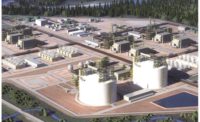The Trump administration may have tabled its $1.5-trillion infrastructure improvement plan until after November’s midterm elections, but the delay hasn’t diminished the urgency of upgrading U.S. bridges, highways, ports, mass transit and wastewater treatment systems. Nor has it necessarily dampened the appetite of design and construction firms for mergers and acquisitions (M&As) that will better position them for infrastructure-related projects, according to a new study by Raleigh, N.C.-based FMI Capital Advisors.
“We saw numerous transactions in 2017 involving companies looking to expand their capabilities in traditional infrastructure markets, such as water and transportation,” says Alex Miller, managing director of FMI and author of the report, “2018 M&A Trends for Engineering and Construction.”
The report was based on a survey of prominent design and construction executives, the majority of them U.S.-based, in addition to FMI evaluations of industry transactions.
“While a federal plan would have a positive impact on infrastructure acquisition activity, it isn’t the only driver, and buyers remain acquisitive in this sector for other reasons, including seeking to expand their capabilities in alternative delivery methods and positioning themselves in attractive geographic markets,” Miller says.
Robust Year
All told, 2017 proved robust for industry M&As, as FMI anticipated, and momentum should accelerate in 2018, according to the report. Among its key findings: Nearly 70% of respondents indicated that acquisitions are “a part of [their] current strategy, as compared to 60% last year,” Miller says.
By comparison, 2017 M&A activity was similar to that of 2016, when FMI logged nearly 400 engineering and construction transactions in the U.S. and Canada. However, the 2017 deals were larger, including several notable $1-billion-plus transactions. That’s due, in part, to continued consolidation within the AEC industry that has allowed firms to strategically acquire talent, broaden their geographic presence and service offerings, and keep pace with acquisitive competitors, the report notes.
“The demand for talent has begun extending to project management and project engineering.”
– Tim Wilson, National Industry Partner, National Construction and Real Estate Group
Other strategically driven M&As involve the pairing of large design and construction firms to achieve vertical integration for expanding their delivery capabilities. Examples include the 2017 acquisition of Oakland, Calif.-based heavy civil contractor Shimmick Construction by engineering giant AECOM.
Expect to see greater vertical integration among firms as projects grow in size and complexity, says Tim Wilson, national industry partner with Kansas City, Mo.-based National Construction and Real Estate Group. “Large billion-dollar projects in the power, refinery, transit and mixed-use sectors require a broader variety of talent and technical expertise,” he says.
As noted by FMI in previous years, the shortage of qualified labor is hampering the ability of design and construction firms to tackle projects of all sizes, thus prompting acquisitions to achieve growth, Miller says.
“The war for talent is clearly evident,” adds Wilson, and it isn’t limited to foot soldiers. “Due to higher volumes of work, demand for talent has begun extending to project management and project engineering.”
Those circumstances figured into the 2017 acquisition by Madison, Wis.-based architect-engineer Mead & Hunt of EMR in Fenton, Mo., an engineering and construction management firm specializing in food and beverage plants.
The deal was driven by the need for additional resources to design and deliver large, ammonia-cooled refrigeration systems, says Greg Marconnet, vice president, food and beverage, with Mead and Hunt.
EMR’s staff of 30 not only designs the systems in Fenton but also travels to sites to oversee their installation. The two firms currently are “in an integration phase,” says Marconnet. Mead and Hunt has 70 to 90 food and beverage projects in the works nationwide.
In the Money
In addition to easing talent shortages, M&A activity will continue to be buoyed by better availability of financing to public engineering and construction companies, FMI says.
Deals are intended to help firms “diversify core businesses, expand into new markets or gain leverage through larger, consolidated platforms,” Miller says. More than 20% of 2017 M&As among engineers and contractors involved a public buyer, the highest level since 2011, FMI reports.
And the deals keep coming. Earlier this year, Watsonville, Calif.-based Granite Construction, a heavy civil contractor specializing in transportation, announced plans to purchase The Woodlands, Texas-based Layne Christensen, a water management and drilling contractor.
The known details include a $565-million stock-for-stock transaction. Upon completion, the merger should establish Granite as a national leader in transportation and water infrastructure, industry analysts say.
Other deals involving publicly owned firms include the recent merger between Houston-based McDermott International and Chicago Bridge & Iron Co. that creates a vertically oriented on- and offshore engineering and construction company.
The M&A trend has its limits, however. “The industry’s engineering and construction sectors are not dominated by publicly owned firms,” Wilson notes.
In the meantime, the industry also is seeing increased investment by private equity firms with plenty of capital and an eye on the attractive near-term profits possible with engineering and construction firms, Miller says.
Those targets include firms with experience in energy transmission and distribution, due in part to the extensive need for modernization and maintenance in the power grid.
Seeking U.S. Partners
Upon its 2017 minority investment in Union, Ill.-based INTREN—the Midwest’s largest M/WBE and a provider of construction, design and maintenance services for leading gas and electrical utilities—Chicago-based One Equity Partners (OEP), a middle-market private equity firm, said that the domestic market for utility contractors is poised for growth, having reached $53 billion last year.
For its part, INTREN, with its 1,300 employees, discovered that larger clients, including Exelon, wanted to partner with it in several U.S. locations. The OEP investment will assist the firm in “growing coast to coast,” says firm CEO Kelly Tomblin.
Rather than pushing to achieve growth, other firms—including those owned and operated by aging baby boomers—are looking to M&As as an exit strategy. FMI’s 2017 “Ownership Transfer and Management Succession Survey” found that only 32% of all respondents plan to pass businesses to succeeding generations, as compared with 53% who indicated they planned to do so in 2013.
“Demographic succession needs, combined with increased buyer interest, are resulting in a robust M&A market for engineering and construction companies,” Miller says.






Post a comment to this article
Report Abusive Comment